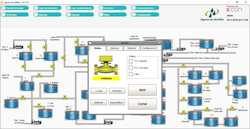Water Agency Uses Application Platform to Welcome the Future
While many water and wastewater facilities stick with outdated supervisory control and data acquisition (SCADA) systems, Aguas de Saltillo in Mexico is taking a different path and accelerating toward Industry 4.0—and is seeing numerous benefits today.
Aguas de Saltillo provides drinking water and wastewater services to residential, commercial and industrial customers in Saltillo, Mexico. With 725,000 residents, Saltillo is the 19th-largest metro area in the country.
Aguas de Saltillo seeks technologies to improve efficiency at its facilities. It has been using Ignition by Inductive Automation for four years. Ignition is an industrial application platform with tools for building solutions in SCADA, human-machine interface (HMI) and the Industrial Internet of Things (IIoT).
“With Ignition, it’s very easy to develop new projects,” said Juan Diego Bravo Ruiz, process engineer for Aguas de Saltillo. “It’s also easy to launch new clients. And it’s a very open system, so it can communicate very easily with all the devices on the market.”
Big Opportunities, Little Cost
Another benefit, Ruiz said, is that Ignition is less expensive than other systems. “I was surprised at how inexpensive it is, considering all the things it can do,” he said.
Aguas wanted to add more tags and devices, but that would have cost additional money with its previous SCADA system. With Ignition, the number of licenses is unlimited—at no additional cost—so Aguas can focus on getting the work done instead of spending time figuring out how to pay for it. “Now, we can expand our system as much as we want,” Ruiz said.
The new software has removed economic and technological barriers to growth, and it is helping Aguas create its solutions for the future. “It’s not just SCADA,” Ruiz said. “It’s a platform for Industry 4.0. It’s much more than SCADA, and that’s what we need today.”
Ruiz is impressed with the speed with which he could implement the software. He also likes the fast development capabilities, the ability to monitor systems with mobile devices and the alarm features. “And above all, the flawless and reliable behavior since we started working with it,” he said.
Aguas de Saltillo uses Ignition for three key projects:
SCADA for production. Aguas depends on Ignition for SCADA with its production and distribution of water. The software helps monitor and control wells, tank levels, valves and more. It provides production reports, flow rates, uptime statistics, volume numbers and many other types of information. It is valuable data that Aguas simply couldn’t see before.
“With the older SCADA, we were unable to launch multiple clients and work with [an] SQL Server database,” Ruiz said. “We were looking for a way to do reports. How much water we produce every day, how much energy we consume, how much time we spend working on the wells—we now have all this information.”
Water meter testing. Aguas is writing scripts and algorithms on Ignition to help analyze data that is gathered while testing water meters. The test results help Aguas decide which meters to purchase, where they should be placed and how to get more efficiency out of the meter system. Aguas can print PDFs of test results. Employees can view charts, graphs and other data displays. The huge amounts of data enable better decision-making.
“Sectorization” with geo-SCADA. Aguas is using the software to improve the efficiency of more than 200 water sectors in the region. It is an ambitious venture that is expected to pay big dividends. The software will be integrated with a geographic information system (GIS) to provide an extremely efficient way to manage all the sectors.
On the GIS maps, Aguas will use color-coding to indicate various levels of efficiency. The new system will help determine the locations of problems and will eventually be integrated into the maintenance application as well. It will show alarms, tendencies and behaviors in all 200-plus sectors.
Aguas has plans to do even more in the future. “The more we know about the software, the more we use it,” said Ruiz. “It’s a very good platform—not just to build SCADA systems, but also to build applications that help you process all the information you have.”

